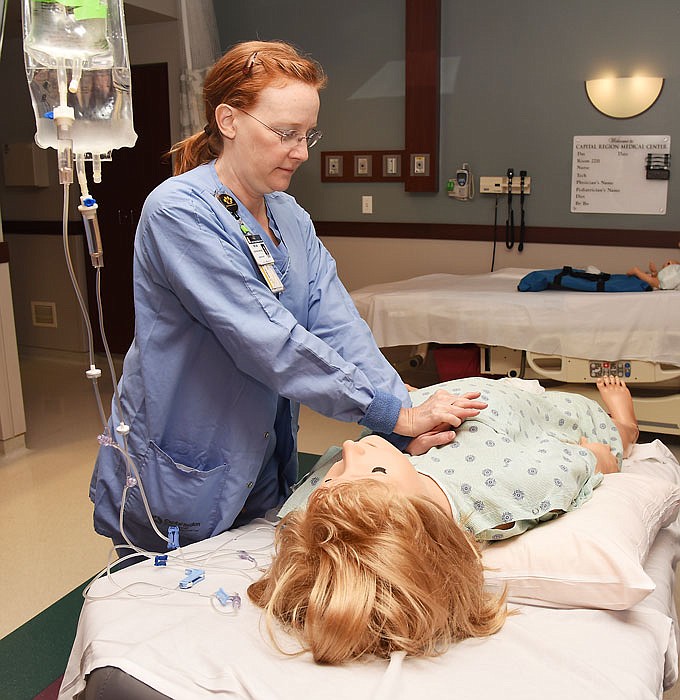Finding and keeping highly trained medical professionals remains a challenge across the state, and Central Missouri is no exception to the trend, according to the Missouri Hospital Association's 2018 Workforce Report.
Hospitals struggle to recruit and retain highly trained positions and especially entry-level positions, but also have to deal with high turnover rates.
Released at the end of July, the MHA report shows the turnover rate - the percentage of employees lost and replaced - among registered nurses in the state increased from 14.5 percent in 2017 to 16 percent in 2018.
Workforce challenges in health care are best understood through looking at turnover rates and vacancy rates, according to the report.
Two years ago, shortly after St. Mary's Hospital opened in its new location in Jefferson City, the hospital was able to cut its turnover rate to about 8 percent. It attributed its success to the new facility, "hiring the right people" and following through on its mission. It has been able to maintain a low turnover rate, talent acquisition leader Dawn Sweazea said.
"This statistic can fluctuate month-to-month," she said in a written statement to the News Tribune, "but we remain focused on this goal and have continued to experience success in this area."
People "stick" at the hospital, Sweazea said, because of its culture. They want to be a part of a team that shares their values.
"We specifically look for individuals who want to be a part of something amazing," she said. "You hear that in our mission statement."
The mission statement is just 13 words: "Through our exceptional health care services, we reveal the presence of God."
People who become part of the hospital's "heritage of healing" don't want to leave it, Sweazea said.
Having two hospitals makes Jefferson City unique to other cities its size in the region, said Dave Dillon, MHA vice president of public and media relations. That attracts more talent.
The News Tribune reached out to Capital Region Medical Center, but did not receive responses to questions before publication.
What "jumps off the pages of the report" for Dillon are the numbers of vacancies for advanced practice registered nurses in the Central Region. These include nurse practitioners, clinical nurse specialists, nurse anesthetists or nurse midwives, who oftentimes provide primary or preventive care for patients.
"Although the raw number of practitioners isn't high, the vacancy rate for APRNs is very high in the region," Dillon said, "and the turnover rate for physician assistants is astronomical."
The region, made up of 19 counties in the heart of the state, is home to 20 hospitals.
Within the Central Region, there are 30 APRN positions filled and 17 vacant, 36.2 percent.
With 383 vacancies, 11.4 percent of registered nurse positions in hospitals remained unfilled. Meanwhile, 14 percent of the positions experienced turnover.
RN vacancy in Central Missouri is nearly the highest it has been since the MHA began collecting workforce data - about 17 years.
"Both vacancy and turnover rates, if not at historic highs are certainly at levels that are very troubling," Dillon said.
Meanwhile, turnover decreased by 2.4 percent in the region from year to year.
"Turnover is generally indicative of workers moving within the profession - between hospitals, from a hospital to a clinic or to another setting," according to the report.
The vacancy rates generally reflect movement within the profession and signal high demand, meaning high opportunities for skilled health professionals, Dillon said.
"But vacancies signal that there are simply too few of these providers to keep them staffed in the area," Dillon said.
In Central Region hospitals, there are 2,986 staff nurses working, with 383 staff nursing positions available.
The region's hospitals have nine physician assistants, with all the positions filled. But there has been a 66.7 percent turnover rate, meaning two-thirds of the PAs have changed locations over the past year.
PAs are medical professionals who diagnose illness, develop and manage treatment plans, prescribe medications, and often serve as a patient's principal health care provider, according to the American Academy of Physician Assistants. They receive thousands of hours of medical training and practice in every state.
"Smaller and rural hospitals tend to use different tactics to attract and keep employees," Dillon said.
When there is a high level of vacancy, employers are forced to look at a variety of tools to attract and keep enough employees.
St. Mary's Hospital offers programs that help it retain employees, Sweazea said.
The hospital is invested in making certain every new employee has tools and resources they need to be successful.
"We have a very detailed and thoughtful onboarding program that starts the moment a person is offered a spot on our team and follows them through the first several months they are with us," Sweazea said. "That includes a variety of on-the-job shadowing, classroom-style training, being paired with a preceptor."

